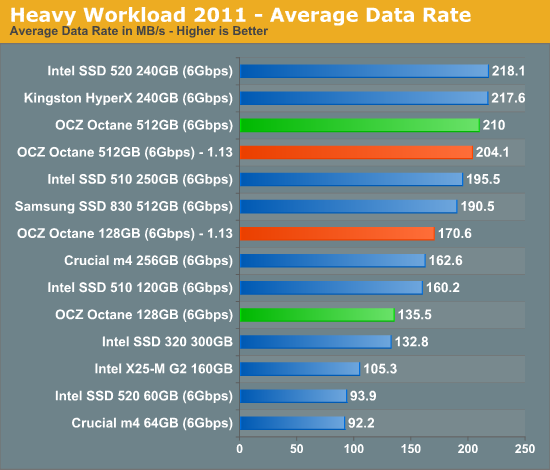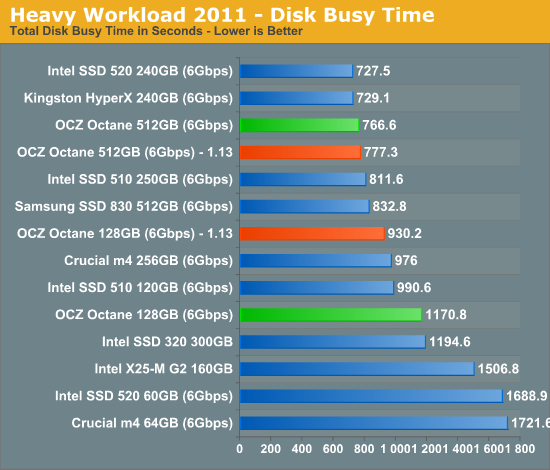OCZ Octane 1.13 Firmware Update: Improving 4KB Random Write Performance
by Anand Lal Shimpi on February 9, 2012 11:21 PM ESTAnandTech Storage Bench 2011
Last year we introduced our AnandTech Storage Bench, a suite of benchmarks that took traces of real OS/application usage and played them back in a repeatable manner. I assembled the traces myself out of frustration with the majority of what we have today in terms of SSD benchmarks.
Although the AnandTech Storage Bench tests did a good job of characterizing SSD performance, they weren't stressful enough. All of the tests performed less than 10GB of reads/writes and typically involved only 4GB of writes specifically. That's not even enough exceed the spare area on most SSDs. Most canned SSD benchmarks don't even come close to writing a single gigabyte of data, but that doesn't mean that simply writing 4GB is acceptable.
Originally I kept the benchmarks short enough that they wouldn't be a burden to run (~30 minutes) but long enough that they were representative of what a power user might do with their system.
Not too long ago I tweeted that I had created what I referred to as the Mother of All SSD Benchmarks (MOASB). Rather than only writing 4GB of data to the drive, this benchmark writes 106.32GB. It's the load you'd put on a drive after nearly two weeks of constant usage. And it takes a *long* time to run.
1) The MOASB, officially called AnandTech Storage Bench 2011 - Heavy Workload, mainly focuses on the times when your I/O activity is the highest. There is a lot of downloading and application installing that happens during the course of this test. My thinking was that it's during application installs, file copies, downloading and multitasking with all of this that you can really notice performance differences between drives.
2) I tried to cover as many bases as possible with the software I incorporated into this test. There's a lot of photo editing in Photoshop, HTML editing in Dreamweaver, web browsing, game playing/level loading (Starcraft II & WoW are both a part of the test) as well as general use stuff (application installing, virus scanning). I included a large amount of email downloading, document creation and editing as well. To top it all off I even use Visual Studio 2008 to build Chromium during the test.
The test has 2,168,893 read operations and 1,783,447 write operations. The IO breakdown is as follows:
| AnandTech Storage Bench 2011 - Heavy Workload IO Breakdown | ||||
| IO Size | % of Total | |||
| 4KB | 28% | |||
| 16KB | 10% | |||
| 32KB | 10% | |||
| 64KB | 4% | |||
Only 42% of all operations are sequential, the rest range from pseudo to fully random (with most falling in the pseudo-random category). Average queue depth is 4.625 IOs, with 59% of operations taking place in an IO queue of 1.
Many of you have asked for a better way to really characterize performance. Simply looking at IOPS doesn't really say much. As a result I'm going to be presenting Storage Bench 2011 data in a slightly different way. We'll have performance represented as Average MB/s, with higher numbers being better. At the same time I'll be reporting how long the SSD was busy while running this test. These disk busy graphs will show you exactly how much time was shaved off by using a faster drive vs. a slower one during the course of this test. Finally, I will also break out performance into reads, writes and combined. The reason I do this is to help balance out the fact that this test is unusually write intensive, which can often hide the benefits of a drive with good read performance.
There's also a new light workload for 2011. This is a far more reasonable, typical every day use case benchmark. Lots of web browsing, photo editing (but with a greater focus on photo consumption), video playback as well as some application installs and gaming. This test isn't nearly as write intensive as the MOASB but it's still multiple times more write intensive than what we were running last year.
As always I don't believe that these two benchmarks alone are enough to characterize the performance of a drive, but hopefully along with the rest of our tests they will help provide a better idea.
The testbed for Storage Bench 2011 has changed as well. We're now using a Sandy Bridge platform with full 6Gbps support for these tests.
AnandTech Storage Bench 2011 - Heavy Workload
We'll start out by looking at average data rate throughout our new heavy workload test:

The good news is that overall performance is mostly unaffected. The 512GB drive took a little drop while the 128GB drive actually saw overall performance increase.
The next chart represent sthe same data, but in a different manner. Instead of looking at average data rate, we're looking at how long the disk was busy for during this entire test. Note that disk busy time excludes any and all idles, this is just how long the SSD was busy doing something:











23 Comments
View All Comments
iwod - Thursday, February 9, 2012 - link
Get M4 ( Or Marvell Based ) if you want Stable and Top Notch Performance.Get Sandforce Based Drive if you only care about Performance.
Samus - Friday, February 10, 2012 - link
Don't forget Sandforce is generally cheaper, especially their mature first-gen controller based drives like the $120 Sandisk 120GB, or recentlky the Patriot $105 120GB drive.Ammaross - Friday, February 10, 2012 - link
"...or recently the Patriot $105 120GB drive. "The Patriot Pyro you're mentioning is based on a Sandforce 2281 controller, so SATA3 and second-gen. But yes, definitely cheaper than most (all) worthy alternatives.
GrizzledYoungMan - Friday, February 10, 2012 - link
Sorry, but no. I just RMA'ed a 128 gb Crucial m4 because of a numerous issues and incompatibilities stemming from poor firmware. The system wouldn't wake from sleep without modifying the registry (and even then, it wouldn't always work) and the drive would frequently stutter thanks to an unacknowledged (but clearly prevalent, given forum posts about it) issue with Intel RST 10.x drivers.I am now running a 120 gb Intel 320 and loving it. The performance is indistinguishable from the m4, despite the latter's advantage in spec and benches. If anything, the 320 might feel a bit snappier than the m4 (and certainly better than my old 60 gb Vertex... not 2 or 3, just Vertex).
iwod - Friday, February 10, 2012 - link
I can definitely say the performance IS distinguishable from m4 and Intel 320.In terms of stability Intel is in a different league. So i forgot to mention them.
M4 may have its problem, but nothing compare to Sandforce.
ckryan - Friday, February 10, 2012 - link
OCZ deserves credit for continuing to support it's older Indilinx drives with newer FW. While Arrowana FW never materialized for Intel NAND equipped models, their newer FWs are much better.The problem with the Octane isn't necessarily it's performance. The problem is price.
Unless the price drops, there isn't a compelling reason to own one. I'm pleased that OCZ is releasing new FW that positively impacts performance, but until they get the price lower, I wouldn't recommend that shoppers pass up the 830 -- especially at 128GB. Depending on the day, the Samsung 830 128GB is $10 to $20 more. For that price differential, you get better performance and probably better NAND as well.
Correct me if I'm wrong, but I think the 64GB 830 and 128GB Octane are pretty much equal performance-wise.
pc_void - Friday, February 10, 2012 - link
The octane isn't an older drive. It came out not long ago.ckryan - Friday, February 10, 2012 - link
No, I mean it's awesome that OCZ is supporting the original Indilinx with newer FW (like 1.7, and I assume there will be at least one more FW release). OCZ does a lot of things which irritate me to no end, but FW support is not one of them.To me, FW support (both initial and long term) is pretty important, so they deserve credit for that.
The 128GB Octane is actually more expensive than the 128GB 830 today; Newegg is having a sale.
pc_void - Friday, February 10, 2012 - link
Do see what your saying now.eman17j - Monday, February 13, 2012 - link
OCZ bought the indilinx controller thats why its in the octane and thats why they are supporting it. It is their own controller. They arent just trying to help out by supporting some old controller